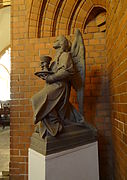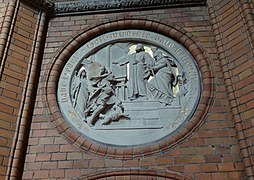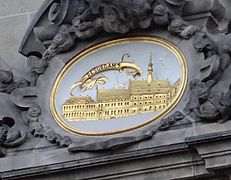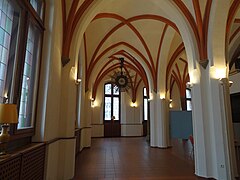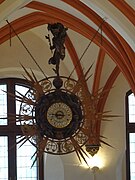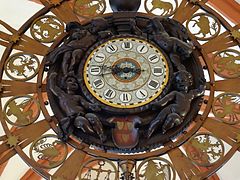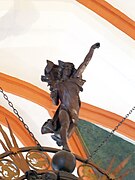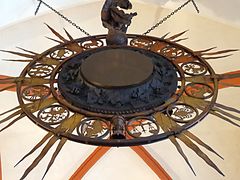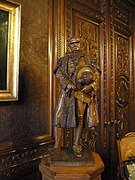Aloys Denoth
Aloys Denoth (born July 4, 1851 in Nauders , Tyrol ; † December 24, 1893 in Hamburg ) was a sculptor and wood carver.
life and work
After training as a sculptor in Innsbruck ( Michael Stolz's workshop ), he went to Meran (Beudl's workshop) for four years . In 1871 he came to Germany and worked as a draftsman. In 1876 he came to Leipzig, where he met his future wife Marie, and worked as a sculptor in Frank Schneider's workshop.
He followed his friend Rudolf Paetz to Hamburg in 1882/83 and opened his own sculpture workshop in the St. Georg district in 1886, and joined the Hamburg Artists' Association from 1832 . Justus Brinckmann , director of the Museum für Kunst und Gewerbe Hamburg , recognized Denoth's extraordinary talent early on and encouraged him. Aloys Denoth died at the age of only 42. He could no longer see the inauguration of the Hamburg City Hall. He was buried in the Ohlsdorf cemetery, but his grave near the rose garden and Cordesallee (M 11-49) is no longer preserved today.
Working for St. Johannis (Harvestehude)
For the St. Johannis Church (Harvestehude) designed by the architect Wilhelm Hauers from 1879 to 1882 , Denoth created two angels in adorant posture in 1892. They originally flanked the high altar.
In the crossing of the church, two of the seven relief medallions - "Blessed are the merciful" and "Tobias and the angel" - were also created by Denoth. They are characterized by their special free plastic qualities and, in contrast to the medallions etc. a. by Fritz Neuber (1837–1889) deeper into the room. A small dog loosens up the Tobias scene and shows the lively style of this sculptor.
Working on the Hamburg City Hall
He received state commissions for the entire sculptural image program of the Natural History Museum Hamburg (1889/90 - destroyed in the Second World War), in 1888 on the occasion of the Hamburg customs connection the "Germania" and the "Hammonia" (both destroyed in the Second World War) at the Brooksbrücke to the Speicherstadt , and by the City Hall Building Commission the design of 32 sculptures of the jewelry on the facade of the Hamburg City Hall :
- Phoenix figure
- the gable crowns of the windows on the main floor
- Statue of Emperor Franz II
- Statue of St. Catherine.
The Phoenix on the tower of the Hamburg City Hall:
Exactly 50 years after the Great Fire in 1842, the topping-out ceremony for the “new City Hall” was celebrated on May 6, 1892. In the solemn accompaniment, the flower-wreathed figure of the phoenix was drawn to the town hall by four black horses. The slogan "RESURGAM" - "I get up again" should become reality.
A stonemason foreman spoke the judgment of the painter Arthur Fitger:
- Is just a fun life to look at
- Is it life to create and build.
- If someone offered me a million,
- I never exchanged and laughed at him in derision.
- Compass and rail and square and lead
- Pass through your hands happily and freely.
- Hands they draw and skull he tucks;
- The project arises lightly on the board:
- Stand firmly on top of unsteady scaffolding
- Where the morning wind embraces and kisses us.
- Bricklayer and carpenter hurry,
- He is a stonemason and a locksmith.
- Ashlars of the tower they grow up,
- Point to heaven in all need.
- The little wreath floats lovely on the phoenix.
- What we create stands and lives.
(see HJ Brandt The Hamburg City Hall - Broschek-Verlag Hamburg, 1957 p. 122)
The gable crowning of the windows of the main floor of the town hall: The
prerequisite for the commissioning of the character busts of the “civil professions” was the approval of model sketches, which Denoth presented as plaster models. There were minor change requests. The stonemason-like execution by a Frankfurt construction company Philipp Holzmann began in 1892. Denoth did not live to see the completion.
The Mayor Johann Georg Mönckeberg
The sculptor Engelbert Peiffer
The painter Valentin Ruths
The mayor Carl Friedrich Petersen
The engineer Franz Andreas Meyer
The judge Ernst Friedrich Sieveking
The scholar Justus Brinckmann
The teacher Georg von Neumayer
The architect Wilhelm Hauers
Compared to the plaster models Denoth had to submit for the character busts, changes were made to some of the figures. The same applies to his two bronze figures: Saint Catherine on the left gable facing the Rathausmarkt and on the side facing the Alter Wall Franz II , the last emperor of the Roman Empire of the German Nation, has no headgear. Under the pressure of Napoleon, he had to take off the crown.
Denoth's figures on Hamburg's town hall are considered his main work. While working on it, Aloys Denoth died at the age of only 42.
Other works
He created wood sculptures, reliefs, handicrafts, medals, large sculptures (nine meter high figures in the Hamburg trade and industry exhibition in 1889). In the years 1892-1893 he created four boyish angels with the attributes of the architect family Hanssen and the shipowner family Canel for the common family graveyard Laeisz-Canel-Meerwein-Hanssen in the Ohlsdorf cemetery (V7-8 / W7-8).
Denoth became a member of the Patriotic Society and created a large hanging clock for the Patriotic Society building, which can still be admired on the ground floor in the “Zum alten Rathaus” room. In the inner field it shows an artful clock surrounded by a wooden wreath with 4 carved putti, including the three shields of the painters / artists. The wooden wreath, in turn, is framed by a metal wreath with sunbeams and the 12 zodiac signs and an hourglass as a reminder of transience. Above on the globe is the figure of Mercury (Hermes), the patron god of merchants, with the winged helmet, the herald's staff and winged shoes.
For the German National Applied Arts Exhibition in Munich in 1888, he designed two sculptures that are now in the Hamburg City Hall: The wood-carved statue of Mayor Max Theodor Hayn (almost 90 cm high) is located in the so-called orphan room of the City Hall and by the window in the Phoenix Hall today the " aneroid barometer " with its artistic carvings. The barometer originally belonged to the Association for Art and Science, which was located in the building of the Patriotic Society.
The peculiarity of the aneroid barometer was rated so highly that Justus Brinckmann's draftsman Wilhelm Weiland signed it and published it with an explanatory text in the journal “Kunstgewerbeblatt” no. 5.1894.
For a long time, Denoth had his workshop in Lindenstrasse 13 (St. Georg district), in the same house as the leather artist Georg Hulbe . The historic Hamburg address book reports the move to Hammerbrookstrasse 15 / Hhs for 1893 (the year Denoth died).
After his sudden death, Justus Brinckmann held a memorial exhibition in the Museum of Art and Industry in Hamburg in 1894. An elaborate folder with Denoth's wood carvings was also issued. Another exhibition in the Museum of Arts and Crafts took place from September 12 to November 2, 1997 on the occasion of the 100th anniversary of the completion of the Hamburg City Hall.
literature
- HJ Brandt: The Hamburg City Hall . Broschek-Verlag Hamburg, 1957 p. 127.
- Ralph Knickmeier, Wilhelm Hornbostel : Aloys Denoth - Hamburg sculpture between historicism and art nouveau . Accompanying publication 1997.
- Applied arts sheet No. 5.1894 [1]
Web links
- About the aneroid barometer: [2]
- About the renovation in St. Johannis (Harvestehude) : [3]
Individual evidence
- ^ "The Hamburg Cemetery Ohlsdorf - History and Tombs - Volume 2", Hamburg, 1990, pp. 33/34
- ↑ Julius Faulwasser in: 165 Years of Patriotic Society - a Hamburg Yearbook 1930 , p. 56.
- ↑ Aloys Denoth WOOD CARVING WORKS. 30 collotype plates and a portrait of the artist. Published by Carl Griese , Hamburg - 1894.
| personal data | |
|---|---|
| SURNAME | Denoth, Aloys |
| BRIEF DESCRIPTION | Sculptor and wood carver |
| DATE OF BIRTH | 4th July 1851 |
| PLACE OF BIRTH | Nauders , Tyrol |
| DATE OF DEATH | December 24, 1893 |
| Place of death | Hamburg |


